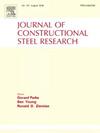Performance evaluation in connection-head-gapped braced frame: Reduced-scale static test and numerical simulation
IF 4
2区 工程技术
Q1 CONSTRUCTION & BUILDING TECHNOLOGY
引用次数: 0
Abstract
Many existing high-rise buildings in Japan conform to outdated codes and require seismic retrofit to meet current standards. While installing additional seismic devices is a proven solution, these devices usually bring additional stiffness, alter dynamic characteristics of structures and exacerbate uneven stress distribution. This paper proposes a novel connection-head-gapped brace to mitigate such adverse effects and safeguard structures during major earthquake events. The novel device incorporates a gapped connection-head above steel braces. When the earthquake-induced frame displacement is small (gap opens), steel braces remain dormant; when the displacement reaches a predetermined threshold (gap closes), the steel braces engage with frame, enhancing lateral stiffness and limiting further frame displacement. Consequently, the connection-head-gapped brace preserves the dynamic characteristics of structures as much as possible and provides additional stiffness only during major earthquake events. A one-span connection-head-gapped braced frame was designed and subjected to a static cyclic test to validate the performance of the novel brace. This paper details the concept and configuration of the novel brace, along with the reduced-scale static cyclic test and finite element simulation of the connection-head-gapped braced frame. The results demonstrate that only after gap closure the steel braces provide additional stiffness and change stress distribution in frame. The novel connection-head-gapped brace presents a promising retrofit solution for enhancing the seismic resilience of existing buildings.
求助全文
约1分钟内获得全文
求助全文
来源期刊

Journal of Constructional Steel Research
工程技术-工程:土木
CiteScore
7.90
自引率
19.50%
发文量
550
审稿时长
46 days
期刊介绍:
The Journal of Constructional Steel Research provides an international forum for the presentation and discussion of the latest developments in structural steel research and their applications. It is aimed not only at researchers but also at those likely to be most affected by research results, i.e. designers and fabricators. Original papers of a high standard dealing with all aspects of steel research including theoretical and experimental research on elements, assemblages, connection and material properties are considered for publication.
 求助内容:
求助内容: 应助结果提醒方式:
应助结果提醒方式:


